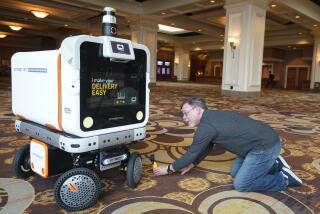Shouldn’t we call it huge-screen TV?
- Share via
Las Vegas — THE sign above the gigantic television declared it to be the “World’s Largest” plasma TV.
How large? 102 inches.
It was so huge that this TV in the LG Electronics booth at the Consumer Electronics Show last week drew a crowd that took snapshots like tourists.
But not far across the jammed Las Vegas Convention Center, Panasonic’s mammoth plasma television was drawing an even bigger crowd. A sign right above the screen proclaimed it the “World’s Largest.” How large? 103 inches.
“Our engineers built the television and measured the screen,” said Panasonic spokesman James Reilly, “and it just turned out to be 103.” Right. And if you believe that, there are casinos that feature loose slots.
The battle to produce the biggest televisions has been going on for years at the annual CES, where manufacturers pull out all the stops in presenting their latest items to dealers, pundits and the media.
The size battle didn’t stop at plasma. Over at the Sharp Electronics booth, the company had the largest liquid crystal display (LCD) television ever at 65 inches. And Texas Instruments featured a projector TV that was showing its image on a 22-foot-wide screen.
But there was a major difference this year when it came to the giant television war. In the past, the huge TVs were mostly prototypes, similar to the concept cars that are shown at auto shows. But some of the biggest of the big screen models at this year’s show were actually headed for the marketplace or already there.
The Panasonic 103-incher goes on sale later this year, although Panasonic executives admitted they’ve made only three so far. They would neither say exactly when the TV would be available nor would they discuss pricing. The Sharp LCD set, which went on sale in November, has a price tag of $20,999. Texas Instruments, which makes components for products that other companies bring to market, said that Christie Digital Systems Inc. was selling the projector TV for $155,000.
Obviously, the giant TVs are for homeowners with very liquid funds and ballrooms converted into home theaters. Or they could be used in meeting halls. You have to stand back 15 to 20 feet to take in the whole screen; otherwise, you’re staring up actors’ nostrils and whipping your head back and forth to take in the whole picture.
As for image quality, these sets had it in somewhat surprising abundance. Sharp’s LCD set was perhaps the best of the giant TVs, with a clarity that rivaled many smaller models. But the Panasonic and LG plasmas also produced images that were startlingly clear.
And although the projected image of Texas Instruments TV suffered from the bright lighting in the convention center (if you can afford the projector, you can likely also afford a screening room with lights that can be dimmed), it sported an exceedingly bright image for a digital projector not meant for cinema use.
In the past, many of the big TVs hauled out for show did not display great quality because image sharpness can dissipate when spread out over a vast area. But technological advances have come to the rescue.
Panasonic, for example, said it has developed a new type of phosphor gas for use in 100 inch-plus TVs. And it has also devised a way to cut down on the interference between gas cells that make up the picture, which is a good thing as there are 2.07 million of these cells in the 103-inch model. Also factoring into the quality in the models was that they were being fed -- and could successfully show -- images at the very high 1080p digital resolution level. That means they had 1,080 vertical lines of image information on their screens, compared with about 480 lines on an old-fashioned analog TV. The more lines, the better the picture.
These televisions -- as well as other 1080p models on display at CES -- were often shown with strange video clips shot just for this purpose. The clips usually featured lithe women, almost always blond. One was wearing what appeared to be a bridesmaid dress and playing the cello, another was languidly staring at a vase and another was with a cat. Very Stepford.
Other clips were available but not on view on the convention floor. “Upstairs in the offices,” an executive said, as if he was going to offer naughty postcards, “we have football.”
He understands what sells. Texas Instruments spokeswoman Molly Mulloy said the projection TV drew its biggest crowds during the Rose Bowl, when the University of Texas pulled off a last-minute victory over USC. “You should have heard the groans with that last touchdown,” Mulloy said.





